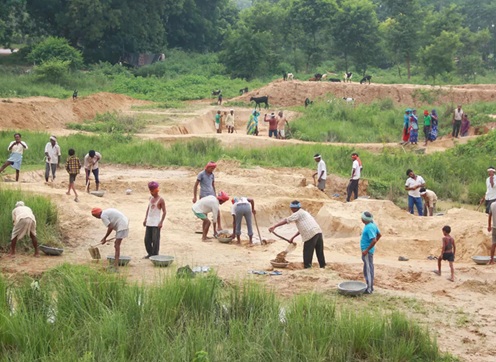| (Mains, General Studies Paper-3: Topics related to Indian economy and planning, mobilisation of resources, progress, development and employment.) |
Context
The Union Rural Development Ministry has directed states to examine “high-cost” works under the Mahatma Gandhi National Rural Employment Guarantee Act (MGNREGA), after irregularities were found in expenditure patterns.

Recent issues related to MNREGA
- The Rural Development Ministry has identified several projects whose cost was proportionately higher than the approved norms.
- The focus is being on works related to land development, water conservation and infrastructure where cost overruns were reported.
- States have been directed to submit reports and take corrective measures to ensure transparency.
- The direction has been issued following CAG observations and complaints of misuse of funds in some districts.
- Most states are yet to share their findings on the scheme.
- Some states, including Tripura, Jharkhand, Mizoram and Chhattisgarh, have shared "partial" reports.
- Though the central government conducts internal audits and field inspections by national-level inspectors, this is the first time it has asked states to specifically check high-cost works.
Significance of the directions
- Accountability in public expenditure: MNREGA is the world's largest social security scheme, which guarantees 100 days of salaried employment. Misutilisation of funds undermines its credibility.
- Centre-state relations: MNREGA is a centrally sponsored scheme; hence, monitoring of funds is important to maintain fiscal discipline.
About the MNREGA scheme
- The scheme was launched in 2006, after the Mahatma Gandhi National Rural Employment Guarantee Act (MGNREGA) was passed by Parliament in 2005.
- It was first launched in 200 most backward rural districts of the country and was extended to 130 more districts in FY 2007-08 and across the country from FY 2008-09.
Financial Allocation and Expansion
- The Centre has spent about Rs 1 lakh crore annually on MGNREGA in recent years.
- For the current fiscal (2025-26), the Centre has allocated Rs 86,000 crore for the scheme.
- The scheme witnessed a surge in demand for work during 2020-21 when a record 7.55 crore rural households availed the scheme in the wake of the COVID-19 outbreak.
- The scheme became a safety net for migrant workers who returned to their villages during the COVID-19 lockdown in 2020.
- The last three financial years (2022-23 to 2024-25) do not include NREGA beneficiary data for West Bengal, where the scheme has been suspended since March 2022.
- Recently, the Rural Development Ministry has sent a proposal to continue MNREGA to the Expenditure Finance Committee (EFC) for approval.
- It has sought an outlay of Rs 5.23 lakh crore for five years till 2029-30.
- The EFC is a central body that evaluates government schemes and projects. It comes under the Finance Ministry.
Way Forward
- Strengthen the social audit mechanism.
- Increase the use of technology (GIS mapping, digital muster rolls, Aadhaar-based payments) for better monitoring.
- Build local capacity to ensure that projects are need-based and cost-effective.


